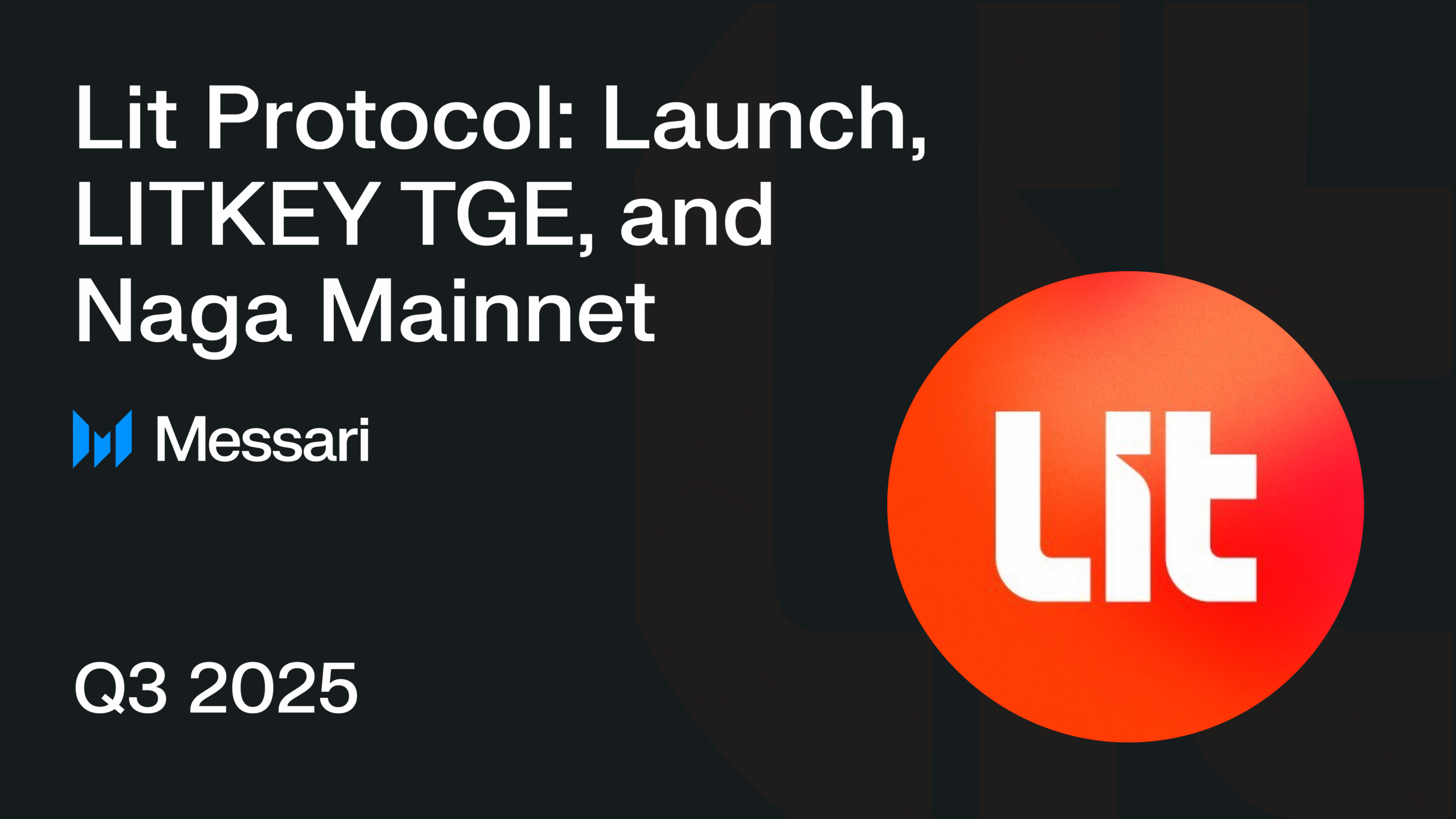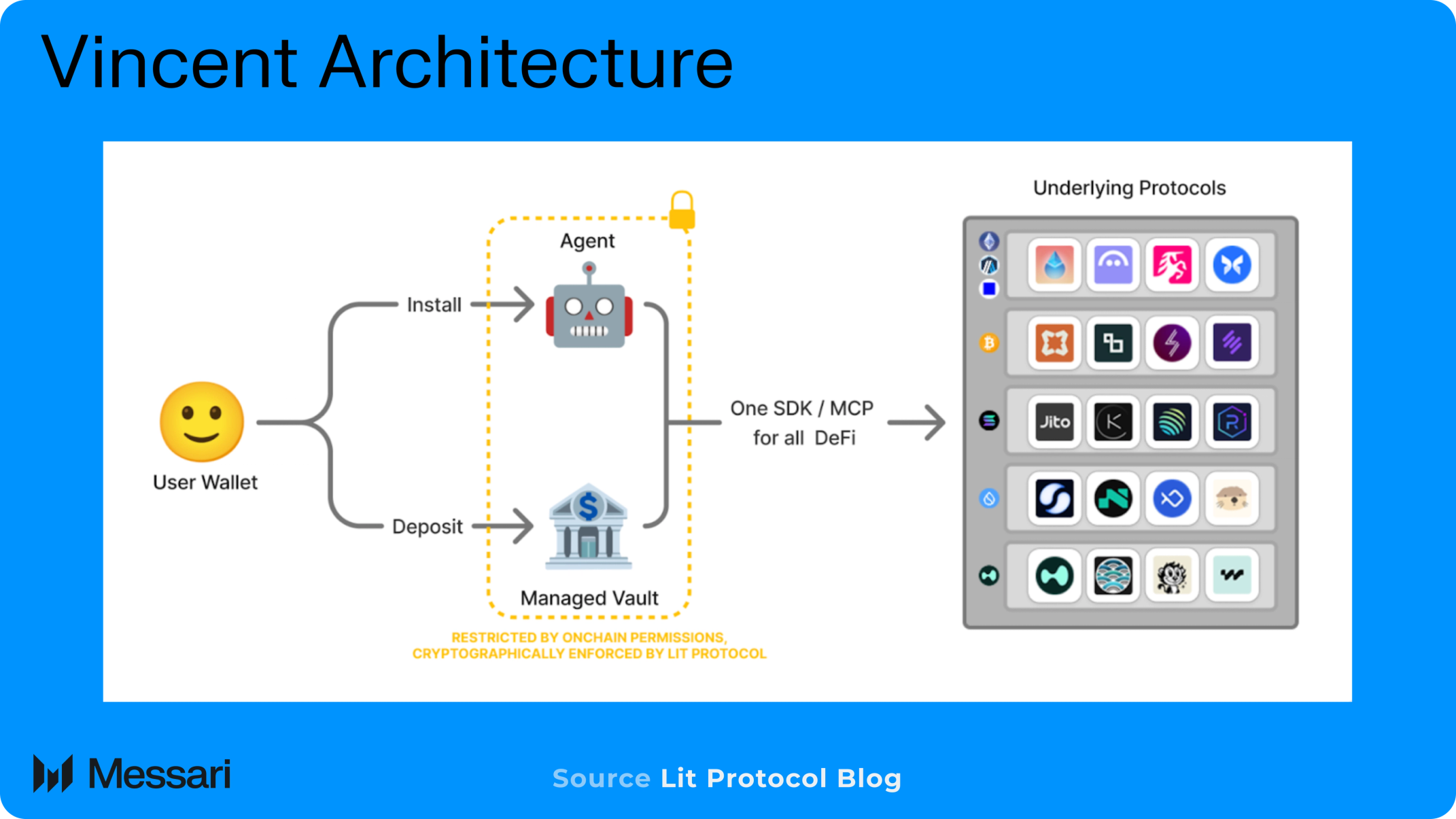Physical Address
304 North Cardinal St.
Dorchester Center, MA 02124
Physical Address
304 North Cardinal St.
Dorchester Center, MA 02124

Lit Protocol is a decentralized key management and private compute network that provides developers with secure signing, encryption, and computation capabilities. Built on multi-party computation (MPC), threshold cryptography, and Trusted Execution Environments (TEEs), Lit enables non-custodial key management, programmable access control, and privacy-preserving compute across blockchains. Its three core services are:
The Lit network consists of a collection of sealed Lit Nodes. Each node performs cryptographic operations in parallel with other nodes. The network requires nodes to achieve a two-thirds consensus to perform signing or decryption, which ensures security and privacy. Lit’s distributed key generation (DKG) model ensures that no single node holds complete key access. Currently, Lit Protocol’s Datil Mainnet Beta is live and manages over $260 million in digital assets. Lit Protocol raised over $15 million in investments from 1kx, Collab+Currency, Sfermion, and more. For a complete primer on Lit Protocol, refer to our Initiation of Coverage report.
Website / X (Twitter) / Discord / Telegram
As autonomous agents and composable smart contracts proliferate across chains, the need for programmable, decentralized control over key management has become increasingly urgent. From user wallets and DAOs to AI-coordinated workflows and confidential compute, applications require infrastructure that can securely sign, encrypt, and execute, without relying on centralized custody or hardcoded logic.
Lit Protocol is building this infrastructure. Initially launched as a threshold cryptography network for distributed key management, Lit has evolved into a programmable coordination layer for multichain agents and applications. Its newest release, Vincent, introduces a developer framework for user-owned agents that can act independently while adhering to onchain permissions. These agents operate across EVM and non-EVM chains, TradFi rails, and compute environments, all backed by Lit’s decentralized signing layer.
This new capability arrives alongside two major milestones: the launch of LITKEY, Lit Protocol’s native token, and the activation of Naga, its v1 mainnet. Together, these unlock staking, governance, and application-layer automation at scale, positioning Lit as foundational infrastructure for secure, autonomous interaction across Web3.
In May 2025, Lit Protocol launched Vincent, a secure wallet delegation framework that lets users authorize AI agents to manage onchain activity within strict user-defined limits. Built on Lit’s threshold cryptography network, Vincent enables developers to ship AI agents and onchain automations with decentralized key management and user-owned permission systems. On September 3, Vincent entered early access, opening the platform to all users and developers for the first time.

Vincent’s architecture consists of four composable primitives:
Vincent apps operate locally or in trusted compute environments and interface with Lit Actions, encrypted JavaScript snippets that request signing from the Lit network using threshold cryptography. This architecture allows agents to perform secure, permissioned operations without centralized custody or cloud-based key infrastructure.
With the early access launch in September, Vincent became publicly accessible to users and developers via the Vincent console and SDK.
Key early access features include:
Developers can use Vincent to create agents that interact with protocols like Aave, Morpho, Uniswap, and deBridge. These agents are governed by explicit permissions and constraints, ensuring non-custodial design by default. Wallet providers can integrate Vincent to offer branded agent ecosystems, yield vaults, and agent marketplaces.
Lit Protocol is preparing for a major milestone with the launch of LITKEY, the native token that will coordinate, secure, and govern the network. The Token Generation Event (TGE) is scheduled for Q4 2025, marking the start of Lit’s transition into a token-incentivized and community-coordinated infrastructure layer.
LITKEY plays three distinct roles within the protocol:
Ahead of the TGE, Lit hosted a community presale from March 24–28, 2025, raising $1.1 million from over 275 participants across 53 countries. The sale was facilitated through Legion and marked an important step in community distribution.

The LITKEY token supply will follow the distribution outlined below:
The TGE activates the full functionality of the Lit cryptonetwork. As staking, governance, and application-level payments go live, LITKEY becomes central to Lit Protocol’s transition from testnet infrastructure to a sovereign, decentralized coordination layer.
Following the LITKEY TGE, Lit Protocol will activate its V1 mainnet, Naga, the successor to the Datil Mainnet Beta. Naga introduces governance and network metering through the LITKEY token and upgrades Lit Protocol’s developer ecosystem.
Node operator selection for Naga’s genesis validator set is community-driven. The top 10 validators will be chosen through a staking and delegation contest, based on total stake-weight. This includes self-staked LITKEY, delegated tokens, and lock duration. Chosen operators must meet minimum self-stake requirements (estimated 100,000 LITKEY), pass identity verification, and operate compliant infrastructure. Once the set is finalized, a Distributed Key Generation (DKG) process will commence, initializing the network’s cryptographic state and bringing the Naga mainnet online.
Ahead of mainnet, Lit launched the Naga Devnet and SDK v8, a complete rewrite of the Lit developer toolkit. The SDK includes support for new signing curves, streamlined APIs for user and session management, and interactive documentation for faster onboarding. Developers currently building on Datil can optionally migrate; both networks will operate in parallel post-launch.
Naga will introduce several core improvements that enhance Lit Protocol’s scalability, interoperability, and developer experience:
Lit Protocol’s transition to mainnet marks a pivotal moment in the evolution of decentralized infrastructure. By combining threshold cryptography, programmable agents, and a robust developer framework, Lit moves beyond key management to become a general-purpose coordination layer for secure, autonomous execution across Web3.
With the introduction of Vincent, Lit establishes a modular framework for AI- and user-driven automation, underpinned by cryptographic guardrails and onchain policy enforcement. The LITKEY token and Naga mainnet bring decentralized incentives, governance, and production-grade performance to this architecture, enabling a broad spectrum of use cases across DeFi, identity, AI, and beyond.
As decentralized applications increasingly rely on automation, cross-chain coordination, and cryptographic security, Lit Protocol introduces a framework designed to support these requirements without centralized intermediaries. Its integration of threshold signing, policy-based permissions, and agent infrastructure provides a technical foundation for building secure and programmable systems. With the launch of its token and mainnet, Lit introduces new governance mechanisms, an improved developer experience, and opens the doors for a new world of autonomous onchian agents.
Let us know what you loved about the report, what may be missing, or share any other feedback by filling out this short form. All responses are subject to our Privacy Policy and Terms of Service.
This report was commissioned by Lit Protocol. All content was produced independently by the author(s) and does not necessarily reflect the opinions of Messari, Inc. or the organization that requested the report. The commissioning organization may have input on the content of the report, but Messari maintains editorial control over the final report to retain data accuracy and objectivity. Author(s) may hold cryptocurrencies named in this report. This report is meant for informational purposes only. It is not meant to serve as investment advice. You should conduct your own research and consult an independent financial, tax, or legal advisor before making any investment decisions. Past performance of any asset is not indicative of future results. Please see our Terms of Service for more information.
No part of this report may be (a) copied, photocopied, duplicated in any form by any means or (b) redistributed without the prior written consent of Messari®.